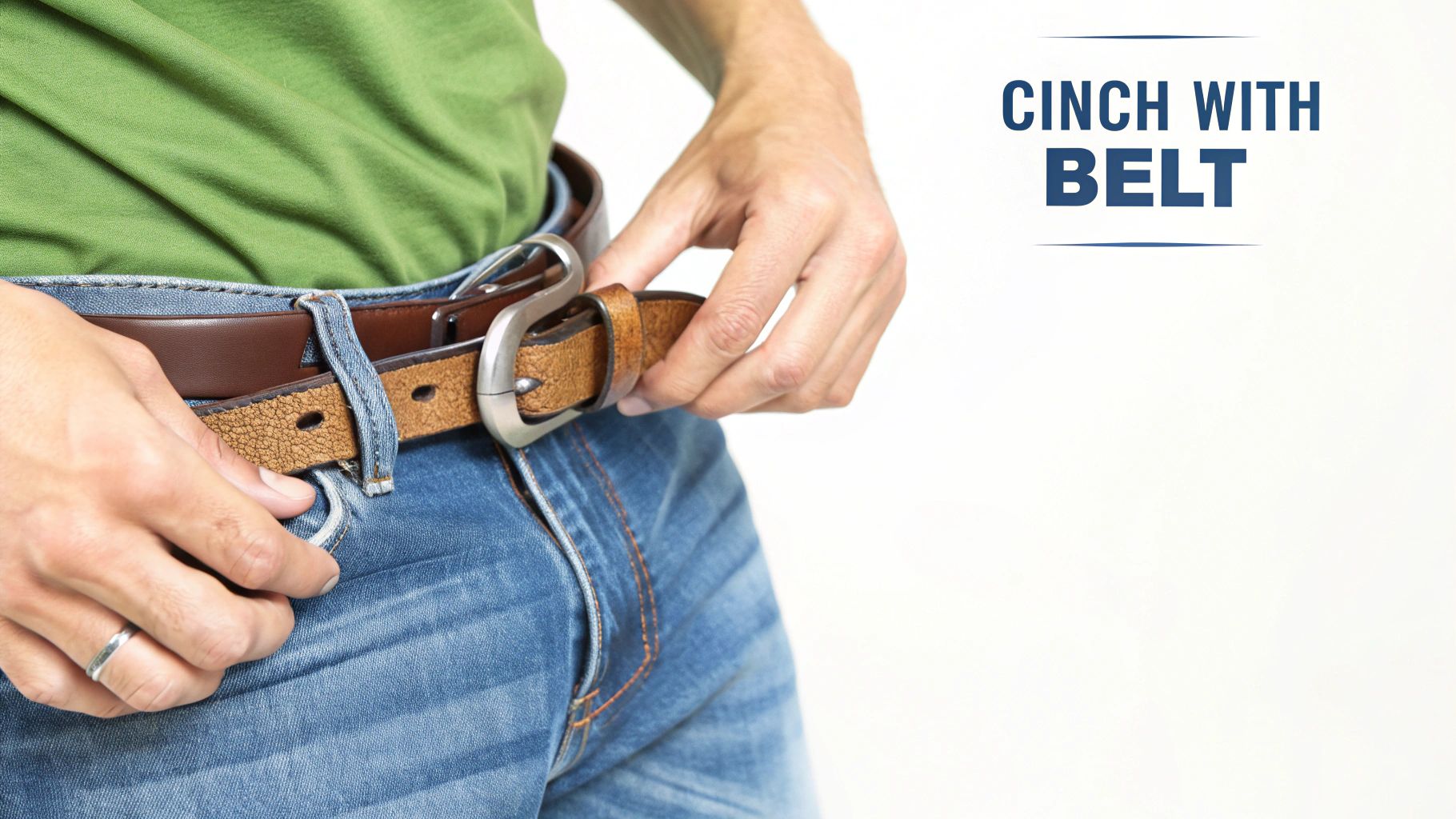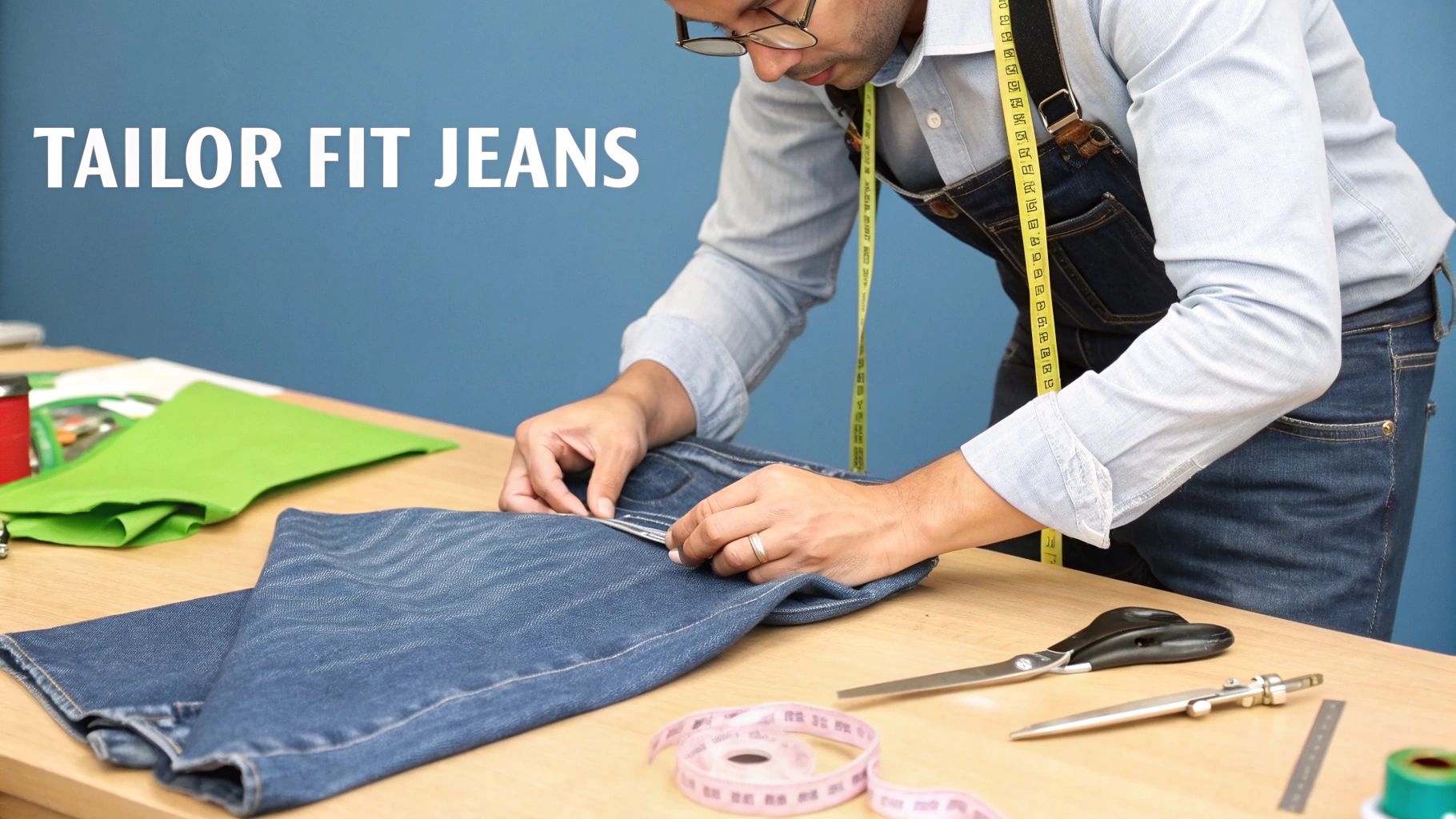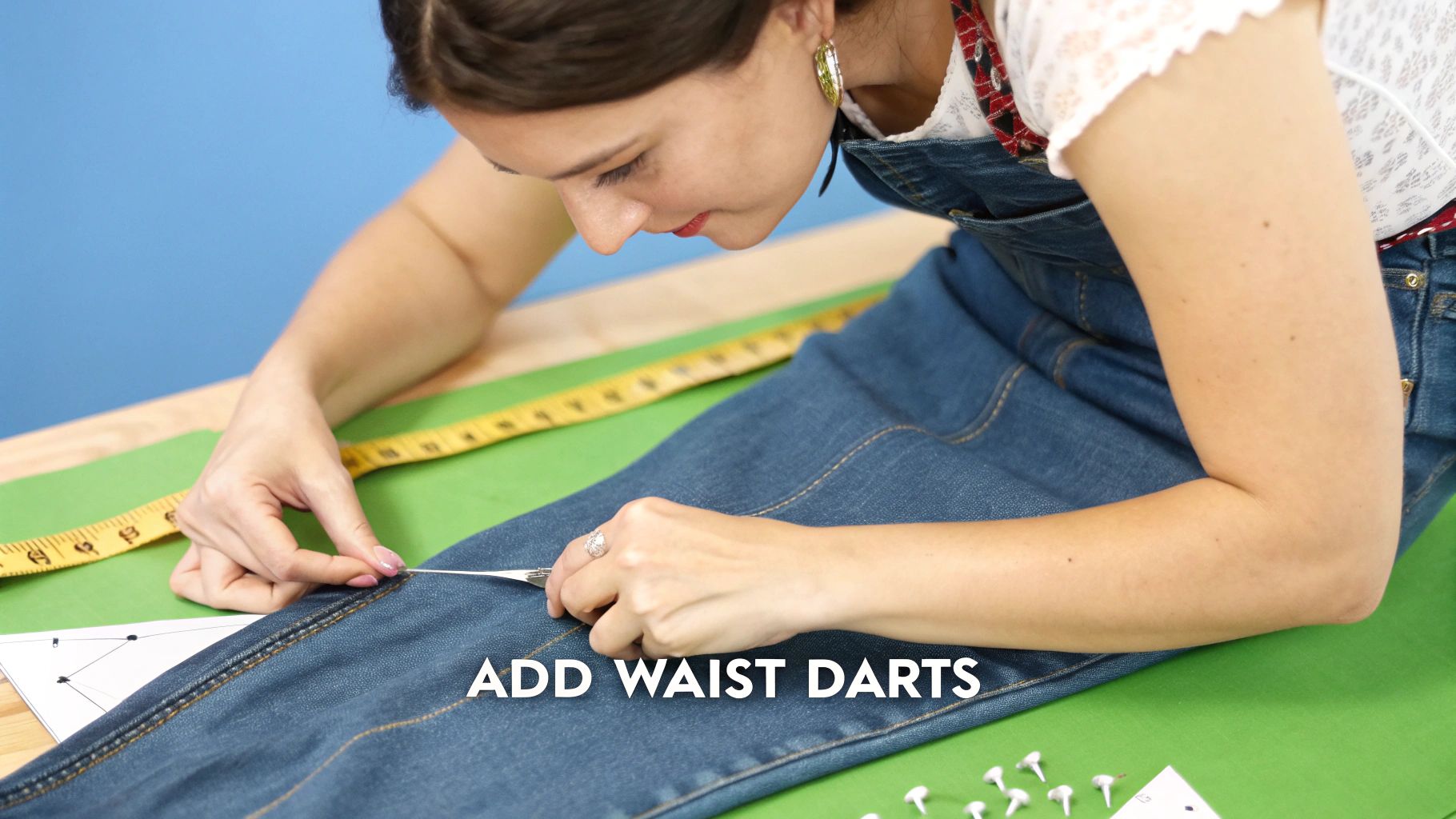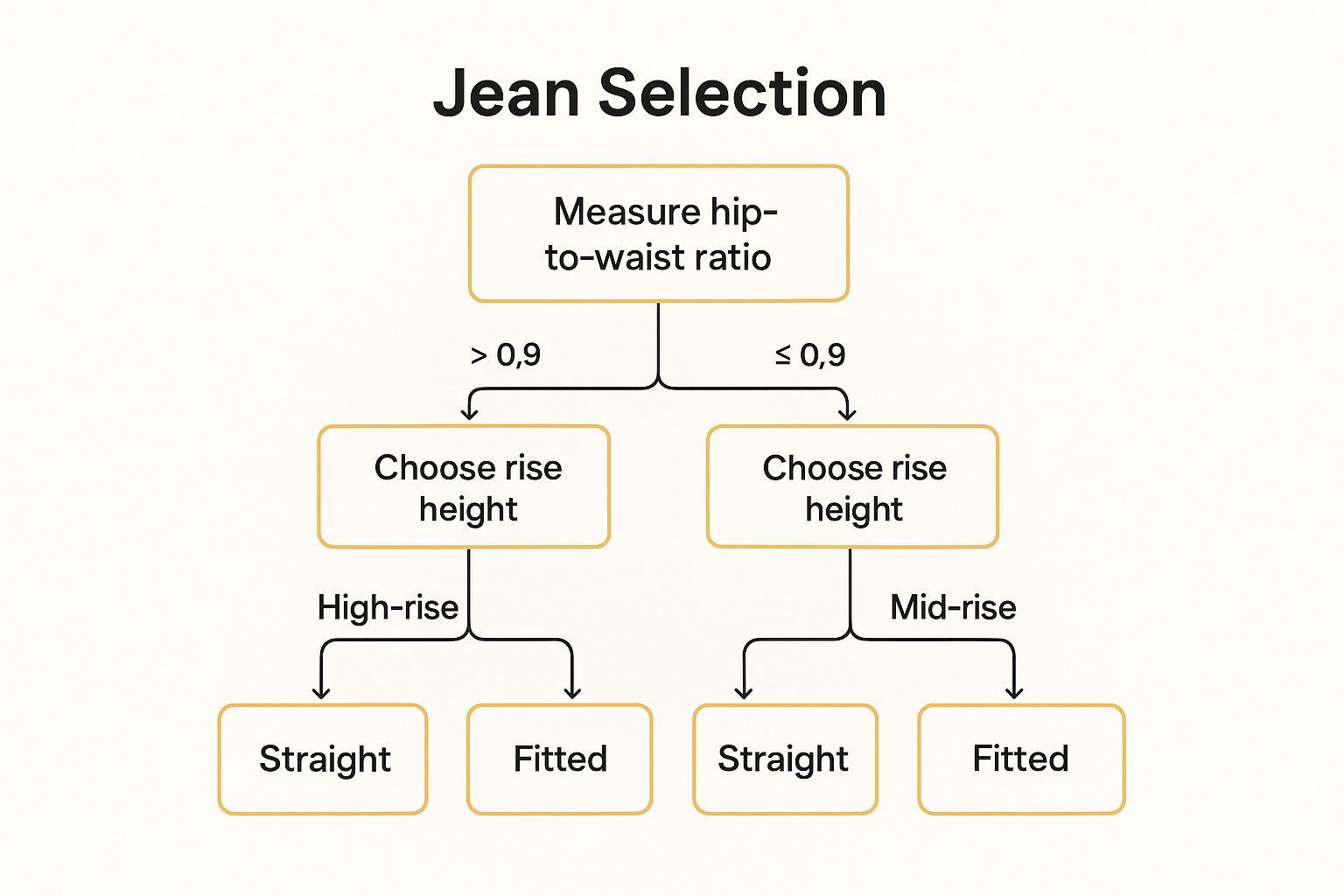
7 Ways to Fix a Jeans Gap in Back for a Perfect Fit in 2025
It's a universal frustration: you find a pair of jeans that fits perfectly through the hips and thighs, only to discover a sizable opening at the small of your back. This common issue, the dreaded jeans gap in back, plagues countless denim lovers. It's not a sign that your body is 'wrong'; it's a sign that the standard jean pattern doesn't account for diverse body shapes, particularly those with a more defined waist-to-hip ratio.
While off-the-rack jeans are designed for an average proportion, many of us need a more customized fit. Brands often build their designs around this very problem, incorporating features like contoured, no-gap waistbands to provide a better fit from the start. However, if you have a beloved pair that's not cooperating, don't despair.
We've compiled a comprehensive roundup of seven effective solutions to eliminate that annoying waistband gap. This guide moves beyond generic advice to provide actionable strategies, from no-sew temporary fixes perfect for a busy day to permanent alterations that give your favorite denim a truly tailored feel. Get ready to achieve that seamless, 'made-for-you' fit and banish the back gap for good.
1. The Classic Cinch: Mastering the Belt for an Instant Fix
The most immediate and well-known solution for the dreaded jeans gap in back is, of course, a great belt. It’s a classic for a reason: a belt works by physically cinching the excess fabric at the waistband, creating a snugger fit that conforms to your natural waistline. While it seems simple, the difference between a sloppy, bunched-up look and a sleek, gap-free silhouette lies entirely in the details of your belt choice and how you wear it.
A well-chosen belt doesn’t just solve a practical problem; it can transform your entire outfit from basic to polished. It's the ultimate non-permanent fix, allowing you to adapt any pair of jeans in your closet for a perfect fit that day, regardless of minor weight fluctuations or the specific cut of the denim.

How to Make a Belt Work for You
Simply threading any old belt through your loops and pulling tight often creates more problems than it solves, like uncomfortable fabric bunching and a distorted silhouette. To effectively close the gap and enhance your look, follow these targeted strategies.
- Choose the Right Proportions: A wide, chunky belt might overpower a petite frame or struggle to fit through the narrow loops of sleeker jean styles. Conversely, a skinny belt may not provide enough tension to close a significant gap on heavier denim. Select a belt width that is proportionate to both your body and the jean’s belt loops for a balanced, effective fit.
- Target Your Natural Waist: For the best cinching effect, ensure the belt sits at your natural waist, which is the narrowest part of your torso. This positioning provides the most leverage to pull the waistband in smoothly, preventing the fabric from folding over on itself.
- Find the “Snug” Sweet Spot: Avoid the temptation to over-tighten. Your goal is a snug fit, not a tourniquet. Pull the belt just enough to close the jeans gap in back without causing the denim to bunch or pucker. A snug fit feels secure but allows you to sit and move comfortably.
Pro Tip: For ultimate customization, consider a braided leather belt. Its design allows you to secure the buckle at any point along its length, offering micro-adjustments that a traditional belt with pre-set holes can't match. This is perfect for getting the tension exactly right.
2. Professional Waistband Alteration
For a truly permanent and seamless solution, professional tailoring is the gold standard for eliminating the jeans gap in back. Unlike temporary fixes, an alteration physically reconstructs the waistband of your jeans, removing excess fabric and re-shaping it to perfectly match your body’s unique contours. This method offers a customized, flawless fit that makes it feel as though the jeans were made just for you.
A well-executed alteration is an investment in your wardrobe, transforming an almost-perfect pair of jeans into a reliable, go-to staple. This is the ultimate fix for high-quality denim that you love but that doesn’t quite fit off the rack, ensuring both comfort and a polished silhouette.

How to Make a Tailor Work for You
Finding a good tailor is key, but communicating your needs effectively is just as important. A successful alteration depends on a clear understanding between you and the professional. To get the best results from your investment, follow these targeted strategies.
- Bring Your Go-To Shoes: The shoes you wear can slightly alter your posture and how your jeans hang. Bring the pair you plan to wear most often with the jeans to the fitting to ensure the tailor can assess the overall fit accurately.
- Wear Proper Undergarments: The undergarments you have on can affect the fit of your jeans. Wear the type you would normally pair with that specific denim to the fitting for the most precise measurements and a truly comfortable final result.
- Discuss the Cost-to-Value Ratio: Before committing, consider the cost of the alteration versus the value of the jeans. It makes perfect sense for a favorite, premium pair but might not be worth it for fast-fashion denim. This is a crucial consideration that many people overlook. You can find more information about jeans with a perfected waist fit on Jag Jeans' official website.
Pro Tip: Ask the tailor to take in the waistband from the back center seam. This is the most common and effective method, as it preserves the original side seams and pocket placement, making the alteration virtually invisible while perfectly closing the jeans gap in back.
3. Dart Addition for Curved Fit
For those with a more pronounced curve from their waist to their hips, a simple cinch might not be enough. This is where tailoring comes in with a highly effective, permanent solution: adding darts. This technique involves creating small, V-shaped folds in the back of the waistband that are sewn down to strategically remove excess fabric, creating a fit that contours perfectly to your lower back.
This is a go-to alteration for premium denim specialists because it addresses the root cause of the jeans gap in back for many body types. Instead of just pulling the fabric together, it reshapes the waistband itself to match your natural silhouette, providing a seamless and incredibly comfortable fit that looks custom-made.

How to Make Darts Work for You
Adding darts is a minor sewing project that yields major results, but precision is key to achieving a flawless finish. While this can be a DIY task for those comfortable with a sewing machine, a professional tailor will ensure a perfect outcome.
- Pin for a Perfect Preview: Before any permanent stitches are made, the jeans should be tried on and the excess fabric at the waistband pinched into one or two darts. Have a friend or a tailor pin them in place so you can see exactly how they will look and feel.
- Prioritize Placement and Symmetry: The most common placement for darts is on either side of the center-back belt loop. This placement allows them to be somewhat disguised and creates a symmetrical, balanced look. Ensure the darts are of equal size and angle to avoid pulling the waistband unevenly.
- Ensure the Right Depth: The depth of the dart determines how much fabric is taken in. A deeper dart removes more material, solving a larger jeans gap in back. It’s crucial to get this right so the fit is snug but not tight, allowing for comfortable movement and sitting.
Pro Tip: When consulting a tailor, specifically ask if they have experience adding darts to denim. The thick, sturdy fabric requires specific needles and techniques to create clean, durable seams that blend seamlessly with the original construction of the jeans.
4. The Hidden Helper: Adding a Waistband Elastic Insert
For a permanent, customized fix that moves with you, installing a small elastic insert in the back of your waistband is a game-changing solution. This technique, popularized by both DIY sewing communities and specialty denim brands, creates a forgiving, flexible fit that eliminates the jeans gap in back without altering the front appearance of your jeans. The hidden elastic panel allows the waistband to stretch and contract, adapting to your body as you sit, stand, and move throughout the day.
This modification is ideal for those who love the look of a specific pair of jeans but need more adaptability in the fit, especially if their waist-to-hip ratio causes persistent gapping. It provides a built-in, invisible solution that feels like the jeans were custom-made for your unique shape.
How to Make an Elastic Insert Work for You
This method requires some basic sewing skills, but the results are professional and long-lasting. Whether you're doing it yourself or taking it to a tailor, focusing on the details is key to achieving a seamless, comfortable fit.
- Position the Insert Strategically: The most effective placement is at the center back of the waistband. To install it, you will open the waistband seam from the inside, cut a small section of the waistband fabric (leaving the outer layer intact), and sew a piece of strong elastic in its place. This keeps the modification completely hidden from the outside.
- Choose High-Quality Elastic: Opt for a sturdy, wide (1 to 1.5-inch) non-roll elastic. This type of elastic is designed to withstand repeated stretching and washing without twisting or losing its shape, ensuring the fix is durable and effective for years to come.
- Match the Color and Tension: For a truly invisible repair, use thread that matches your jeans' waistband. Before sewing the elastic permanently, pin it in place and try the jeans on. Test the tension by sitting and bending to ensure it closes the jeans gap in back comfortably without feeling too tight.
Pro Tip: If you're new to sewing, start by opening a small 4-6 inch section of the inside waistband seam. This gives you enough room to work without deconstructing the entire pair of jeans. Once the elastic is securely stitched, simply sew the inside seam closed for a clean finish. For those who prefer a ready-made solution, many brands now incorporate this feature directly into their designs. You can find more information about jeans designed with stretchy waistbands at JAG Jeans.
5. Strategic Size and Cut Selection
The most effective way to eliminate the jeans gap in back is to prevent it from happening in the first place. Strategic size and cut selection is a proactive approach that focuses on understanding your unique body proportions and choosing denim designed to flatter them. Instead of altering jeans to fit you, you find jeans that were practically made for you from the start.
This method moves beyond generic size tags and empowers you to become an expert on your own fit needs. A proactive approach to achieving a gap-free fit often begins with understanding your body shape and knowing how to take accurate body measurements. By recognizing how different cuts, rises, and fabric blends interact with your waist-to-hip ratio, you can confidently navigate the often-overwhelming world of denim and find your perfect pair.
This decision tree infographic breaks down the jean selection process, helping you choose a rise and cut based on your body’s waist-to-hip ratio.

The visualization highlights how a high waist-to-hip ratio is often best served by high-rise, fitted cuts, while a lower ratio may find a better fit with mid-rise, straight-leg styles.
How to Choose the Right Jean Size and Cut
Shopping for jeans should be a science, not a guessing game. Armed with the right information, you can pinpoint styles that will minimize gapping and maximize comfort. Use these tips to refine your selection process.
- Prioritize Rise for Your Torso: The rise (the distance from the crotch to the waistband) is critical. A high-rise jean is often the best defense against a jeans gap in back for those with a defined waist, as it's designed to sit at the narrowest part of the torso. Mid-rise styles offer a versatile alternative that works for many body types.
- Understand Different Cuts: A "straight fit" is cut straight from the hip to the ankle, while an "athletic fit" provides more room in the seat and thighs before tapering. For instance, Levi's Curvy or Athletic Fit jeans are specifically engineered with a smaller waist and more room in the hips, directly addressing the cause of back gapping.
- Shop at the Right Time: Your body can fluctuate slightly throughout the day. Try on jeans in the late afternoon or evening when you may be a bit more bloated or swollen. This ensures the fit will be comfortable all day long, not just first thing in the morning.
Pro Tip: Ignore the size on the tag and focus on the fit. Sizing is notoriously inconsistent across brands. Grab the size you think you are, plus one size up and one size down. The pair that fits your hips and thighs best is the right one, even if the waist needs a minor tweak later. Learn more about how different styles fit on the JAG Jeans blog.
6. Layered Tank Top or Fitted Shirt
Sometimes the simplest solution is also the most stylish. Instead of altering your jeans, you can strategically use your other clothing to solve the jeans gap in back. A well-chosen fitted tank top or shirt, when tucked in, acts as a functional and fashionable bridge, effectively concealing the gap while helping to anchor your jeans in place. This method provides coverage, smooths your silhouette, and adds a polished, intentional look to your outfit.
This approach is perfect for those who want a quick, non-permanent fix that also enhances their overall ensemble. It’s a practical way to manage the gap without any tools or sewing, making it ideal for busy mornings or when you're transitioning from a casual day to a more put-together evening look. By creating a seamless line from your top to your jeans, the gap simply disappears from view.
How to Make a Layering Piece Work for You
The key to this technique is choosing a base layer that works with your jeans, not against them. A bulky or ill-fitting shirt can create more problems than it solves. To master this layered look and eliminate the gap, follow these guidelines.
- Prioritize a Sleek Profile: The best tops for this job are those made from smooth, thin materials that won't add bulk at the waistline. Look for seamless tank tops, microfiber base layers like Uniqlo’s AIRism line, or shapewear tanks from brands like Spanx. These options lie flat against your skin and tuck in without creating lumps or ridges under your jeans.
- Ensure Sufficient Length: Choose a tank or shirt that is long enough to stay securely tucked in all day. A top that constantly rides up will fail to cover the jeans gap in back and become a source of frustration. A longer cut ensures that even when you bend or sit, your lower back remains covered and the waistband stays supported.
- Coordinate for a Cohesive Look: Select a base layer in a color that either matches your jeans for a monochromatic effect or complements your outer layer. A neutral-colored tank (black, white, nude, or gray) is a versatile choice that works with almost any outfit, ensuring your gap solution looks like a deliberate style choice.
Pro Tip: For maximum comfort and a secure fit, consider a bodysuit. Bodysuits provide the ultimate tucked-in look that will never come untucked, offering a completely smooth line and guaranteed coverage for any waistband gap. For those who find traditional jeans constricting, many modern pull-on styles provide the classic denim look without the hardware, which you can explore in this guide to pull-on jeans.
7. DIY Waistband Adjustment with Fabric and Sewing
For those with basic sewing skills, a do-it-yourself waistband adjustment is a permanent and highly effective solution to the jeans gap in back. This method involves surgically altering the waistband by removing excess fabric and re-sewing the seams for a completely customized fit. It’s a more involved approach, but it offers a professional-level fix without the cost of a tailor.
This technique, popularized by countless YouTube sewing instructors and DIY fashion bloggers, empowers you to take control of your denim’s fit. By precisely removing the extra material causing the gap, you reshape the jeans to match your unique proportions, creating a truly seamless and comfortable silhouette that looks like it was made just for you.
How to Make a DIY Waistband Adjustment Work for You
Taking a pair of scissors and a sewing machine to your favorite jeans can feel intimidating, but with careful preparation, it's a very achievable project. Follow these key steps to ensure a successful alteration.
- Mark Alterations Carefully: Put the jeans on inside out and pinch the excess fabric at the center back seam until the waistband fits snugly. Use a fabric marker or pins to mark exactly how much needs to be taken in. This initial measurement is the most critical step.
- Use the Right Tools: Denim is a tough fabric. A standard needle will likely break. Equip your sewing machine with a heavy-duty denim needle (size 90/14 or 100/16) and use a strong, high-quality thread that matches your jeans to handle the thick layers.
- Start Small and Test Fit: It’s always easier to take more fabric in than to let it out. Begin by sewing a new seam slightly inside your initial markings. Try the jeans on to test the fit before cutting any excess fabric away. This allows you to make micro-adjustments for the perfect level of comfort.
- Preserve Original Details: For a professional-looking finish, try to replicate the original topstitching as closely as possible. Using a topstitching thread in a classic gold or copper color can make your alteration virtually invisible.
Pro Tip: Before attempting this on your favorite pair, practice on an old, thrifted pair of jeans. This will help you get comfortable with the process of detaching the belt loop, opening the waistband seam, and sewing through thick denim layers without risking a costly mistake.
7-Method Comparison for Jeans Back Gap Solutions
| Method | Implementation Complexity 🔄 | Resource Requirements ⚡ | Expected Outcomes 📊 | Ideal Use Cases 💡 | Key Advantages ⭐ |
|---|---|---|---|---|---|
| Using a Belt to Cinch Waistband | Low - instant and simple | Minimal - any belt | Temporary gap reduction; may cause fabric bunching | Minor to moderate gaps; mid/high-rise jeans | Quick, reversible, cost-effective |
| Professional Waistband Alteration | High - requires tailor | Moderate - $15-40 and time (1-2 weeks) | Permanent elimination of gap; maintains original jean look | Severe gaps needing permanent fix | Professional finish; improves comfort |
| Dart Addition for Curved Fit | High - skilled tailoring needed | Moderate - $20-35 | Creates contoured fit; flattering silhouette | Curvy figures with hip-to-waist differences | Addresses root cause; maintains comfort |
| Waistband Elastic Insert | Medium - specialized tailoring | Low to moderate | Adds stretch and adjustability; comfortable for extended wear | Minor to moderate fitting fluctuations | Accommodates weight changes; less costly |
| Strategic Size and Cut Selection | Medium - requires fitting effort | None to low | Prevents gap occurrence; better overall fit | New purchases, body type-specific shopping | Avoids alterations; long-term solution |
| Layered Tank Top or Fitted Shirt | Low - no tailoring | Minimal - existing clothing | Provides coverage and anchors jeans | Minor gaps; instant coverage | Quick, cost-effective, adds outfit layering |
| DIY Waistband Adjustment | High - sewing skills needed | Low - sewing machine + supplies | Cost-effective, customizable alteration | Those with sewing ability and time | Full control; immediate results; cost-saving |
Your Blueprint for a Gap-Free Future
Navigating the world of denim can often feel like a compromise, but the persistent jeans gap in back no longer has to be an accepted frustration. Throughout this guide, we have dismantled this common wardrobe issue, transforming it from an inevitable annoyance into a solvable puzzle. You now possess a comprehensive toolkit filled with strategies that cater to every level of commitment, skill, and lifestyle. The power to achieve a flawless, custom-feeling fit is officially in your hands.
Recapping Your Path to the Perfect Fit
The journey to eliminating that frustrating waistband gap is not a one-size-fits-all path. It’s about understanding the specific cause of your fit issue and aligning it with a solution that makes sense for you. Let's recap the core strategies you've learned:
- Immediate & Temporary Fixes: For those moments when you need a quick, non-permanent solution, a well-chosen belt or a strategically layered tank top offers an instant fix. These are your go-to options for making a slightly-off pair of jeans work in a pinch, perfect for a busy day of errands or a casual brunch.
- DIY & Semi-Permanent Solutions: If you're comfortable with a needle and thread, adding a hidden elastic insert to the back of the waistband is a game-changing adjustment. This simple DIY project offers a flexible, comfortable fit that moves with you, discreetly solving the jeans gap in back without altering the exterior look of your denim.
- Permanent & Professional Alterations: For those investment pairs you adore, professional tailoring is the ultimate solution. Taking your jeans to a seamstress for custom-sewn darts or a complete waistband reconstruction guarantees a truly bespoke fit. This is the gold standard for transforming a good pair of jeans into a great one.
The Most Important Takeaway: Proactive Shopping
While all these fixes are incredibly valuable, the most powerful strategy is a proactive one: choosing the right jeans from the very beginning. Understanding your body's unique proportions, especially your waist-to-hip ratio, is the first step. Look for denim with specific features designed to prevent gapping, such as:
- Curved Waistbands: These are ergonomically shaped to follow the natural curve of your lower back, leaving no room for a gap.
- Contoured Rises: A mid-rise or high-rise that sits at your natural waist often provides a more secure and flattering fit.
- Fabric with Smart Stretch: Look for denim blends that include a small percentage of high-quality spandex or elastane, which allows the fabric to hug your curves without stretching out and losing its shape.
By prioritizing these elements during your shopping process, you shift from reacting to a fit problem to preventing it entirely. This approach not only saves you time and money on alterations but also builds a wardrobe of reliable, comfortable, and flattering staples you can count on day after day. Ending the battle with the jeans gap in back starts on the shopping rack, not at the sewing machine. The perfect silhouette is waiting for you; now you know exactly what to look for.
Ready to skip the alterations and find a perfect fit right off the rack? Explore the collection at JAG Jeans, where every pair is crafted with a signature no-gap, pull-on waistband designed to contour to your shape. Discover denim that eliminates the jeans gap in back by design at JAG Jeans.